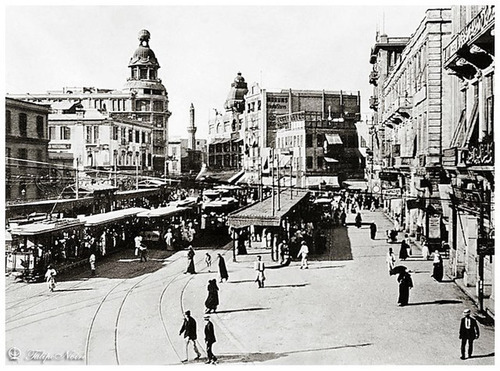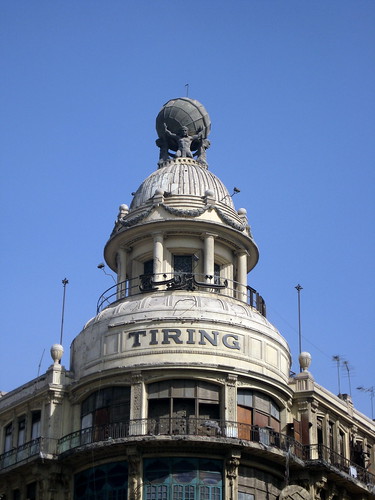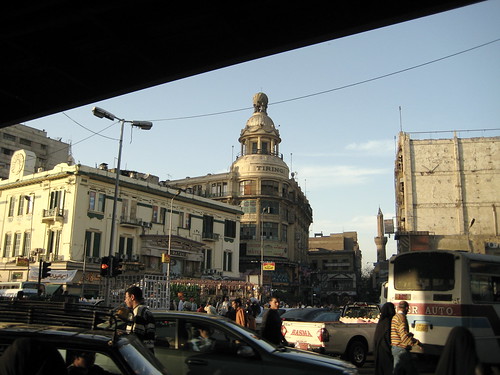Landmark: Tiring Department Store
Visible slightly to the north from the narrow overpass that links Opera Square to Azhar Street is a corner building with four kneeling Atlas statues lifting a glass globe. This was the Tiring Department Store, one of Cairo’s many houses of early twentieth century shopping and consumption of modern goods.
The store was founded in 1910 by Victor Tiring, an Austrian merchant born in Istanbul who specialized in Turkish tailoring. The Tiring family had built its first store in Vienna in 1882. The building was designed by Oscar Horowitz, a Czech architect who studied in Vienna and who designed similar shopping destinations within the Austro-Hungarian sphere. The Tiring Store in Cairo was completed in 1912 and when it opened it was the city’s premier shopping destination for imported luxury goods. With the events of World War I, the British occupation in Egypt had deemed all Austrians and Hungarians as enemies and forced their departure from Egypt. The Tiring department store was only in business for few years and its business was interrupted due to pressure from the colonial administration which forced it into liquidation by 1920.
The five-story building was designed with open floors and an airy feel fit for modern shopping and it would eventually become the desired property by other department store owners but complications due to ownership led to it being abandoned. Shortly after the demise of the short-lived Tiring, the building became home to squatters, primarily small-business and workshops who set up shop in its vast floors. It has been used since by a variety of people for a variety of activities, there was a bar, a mosque, full-time residents, clothing workshops and a cafe occupying the building at one time.

This is the story of many buildings, perhaps hundreds in Cairo and other cities. At first it may appear that the main obstacle confronting any effort to save Tiring building is related to ownership. However, another building not far away, fronting Opera Square and the remaining parcel of Azbakeya Garden is the former Continental Hotel which is also occupied by small workshops informally, yet it is owned by the state. Other buildings around downtown and the surrounding districts have been undergoing a process for decades aimed at intentionally removing links to original owners. Those were the properties of owners who fled the country, were forced out either by the British or subsequent regimes, or properties where heirs immigrated and entrusted the property to a lawyer or anyone who later illegally sold it to themselves and obscured links to the original owners. This has led to legal disputes and often buildings have been “frozen” with no one to claim them as their own and thus they fall for squatters or idle eternally. What I am trying to argue, the Tiring Building brings attention to the legal dimension complicating the potential regeneration, maintenance and reuse of such properties. And this calls for a legal framework and carefully drafted policy.
The Tiring Building was built a century ago, yet it was used by its original owner for its intended use for less than a decade. Despite this, it has become part of the urban heritage of Cairo and its iconic Atlases and glass globe have become a landmark referenced in works of art, literature and seen in film. The building, and others like it, is part of Cairo’s cityscape and it presents us with a challenge of dealing with its complicated history, ownership issues, accommodate/legalize its current users, maintain its architectural heritage, make it economically sustainable and make it accessible to the public.

The building should also be seen in its urban and social context. It sits at a unique location linking old and new Cairo and near Attaba Square where other key buildings such as the fire department and the original post office stand. Near by is the Attaba vegetable market, one of downtown’s central markets, and surrounding streets are bustling with commercial activity. There is massive potential in this area to organize, develop, accommodate current commercial activities while diversifying the uses and users by inserting new ones. However, the scale of needed development in Cairo’s central districts needs new strategies that move beyond the approach of focusing on individual buildings and seeking the needed funds to restore them without considering their relationship to context and their potential new uses. Many of the historic buildings which have been restored by the state following this approach have sat empty for years or have been transformed into “cultural centers” where no real activity takes place.
The Tiring Building is desperately screaming for attention for the entire district to be revitalized in cooperation with its current users. However, with the current governance structure which does not align with community structures in the city there will be no revitalization. Communities in Cairo are full of buildings around which the various districts can develop, whether the Sakakini Palace in Sakakini or the Tiring Building in Attaba, those buildings can act as the starting point in a community-driven, government-led approach that integrates buildings of historic significance with the communities that live in and around them in ways that protect the architectural heritage, stimulate economic development and provide new opportunities. Such efforts need sound policy and such policy needs to build on a political structure that empowers communities rather than treat them as mere squatters to be removed.
5 notes
 youssefhamza15 liked this
youssefhamza15 liked this i-zygzak-blog liked this
grotesqueit reblogged this from cairobserver
grotesqueit liked this
thebaboonshack liked this
cairobserver posted this



